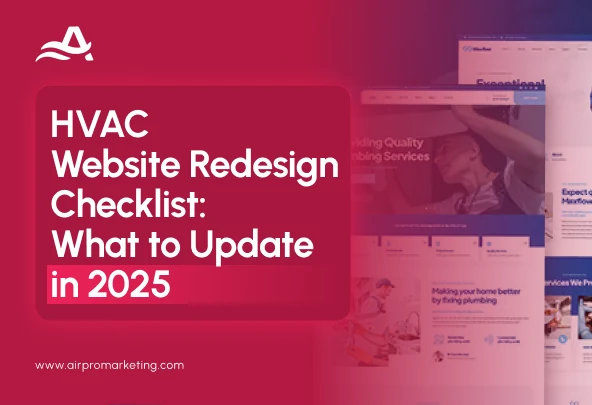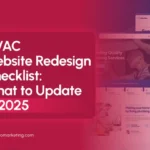Your HVAC website might be costing you business, not because of what’s on it, but because of what’s missing. In 2025, the standards for HVAC web development have shifted. People aren’t just browsing; they’re judging within seconds. According to Forbes, 94% of first impressions are design-related, and 88% of users won’t return after a bad website experience. For HVAC companies, this means slow, clunky, or outdated sites can directly affect call volume and bookings. This isn’t about flashy design, but it’s about trust, speed, and clarity. Below is a checklist that covers what to update, why it matters, and how to do it right.
1. Mobile Optimization Isn’t Optional Anymore
If your website isn’t responsive or easy to use on a phone, you’re already losing leads. Users expect fast loading, click-to-call functionality, and a layout that feels natural on smaller screens. Poor mobile experience doesn’t just frustrate users; it pushes your site down in search engine rankings. According to Semrush, more than 60% of searches now come from mobile devices. Moreover, Google prioritizes mobile-first indexing, which means your mobile performance defines your SEO.
What to focus on:
- Design a responsive layout that adjusts for all screen sizes
- Enable thumb-friendly navigation with larger buttons
- Ensure fast load times (under 3 seconds is ideal)
- Optimize images for mobile viewing
- Test the site on both Android and iOS
2. Speed and Core Web Vitals Compliance
Page speed isn’t just about convenience; it’s about credibility. In HVAC web development, slow sites often fail to convert because homeowners are in a hurry. They need immediate solutions. That’s why Google’s Core Web Vitals matter more than ever in 2025. These metrics measure how fast, stable, and interactive your website is.
Checklist items:
- Use tools like PageSpeed Insights to evaluate performance
- Minimize JavaScript and CSS bloat
- Enable lazy loading for images
- Use next-gen image formats like WebP
- Choose a fast, HVAC-optimized hosting provider
3. Update Service Pages with Real Information
Generic service pages won’t cut it anymore. In 2025, HVAC customers want clear, local, and accurate service descriptions. They’re looking for details on what’s included, typical pricing, and how long jobs take. Without that, they’ll just move on to a competitor. Updated service pages help your SEO and improve your conversion rate by building trust.
What to include:
- Specific services with individual pages (AC installation, furnace repair, etc.)
- Service area details and local references
- Time estimates and transparent pricing ranges
- Clear CTAs like “Schedule Inspection” or “Get a Free Quote”
4. Add High-Intent Conversion Features
Conversion-focused design is what separates a pretty website from a functional one. Homeowners aren’t browsing for fun, but they’re looking for a fast way to solve a problem. That’s why you need visible, easy-to-use conversion points across your site.
Key elements to integrate:
- Sticky header with phone number
- Online scheduling tool
- Contact forms above the fold
- Chatbots for instant response (especially after hours)
- Scroll-triggered CTAs on longer pages
5. Prioritize Local SEO Elements
Almost 21% of consumers use the internet to find local businesses, and search engines rely heavily on your website’s structure to determine local relevance. For HVAC web development in 2025, it’s critical to include local SEO signals directly on your site. This helps Google associate your business with a specific area.
Checklist updates:
- Add schema markup for a local business
- Create and link to Google Business Profile
- Include city names in title tags and H1s
- Add testimonials with location mentions
- Embed a map with your business location
6. Make Your Site ADA Accessible
Accessibility is no longer a courtesy, but it’s a legal and ethical necessity. The Americans with Disabilities Act (ADA) requires certain accommodations on websites. A non-accessible site could alienate users or even lead to lawsuits. For HVAC companies serving a wide demographic, including older users, ADA compliance matters.
Steps to follow:
- Use high-contrast color schemes
- Add alt text to all images
- Enable keyboard navigation
- Avoid flashing elements or autoplay media
- Use ARIA labels for screen readers
7. Upgrade Your Content with Value and Clarity
Content still drives trust. In 2025, users want short, clear explanations and proof that you know your field. Thin, keyword-stuffed content won’t work anymore. Instead, go for clear service benefits, FAQs, and how-to sections that help customers feel informed before they contact you.
Enhance your content by:
- Adding a robust FAQ section for each service
- Including customer testimonials and reviews
- Writing 300–500 words per service page
- Avoiding jargon and speaking in terms your customers use
- Using internal links to guide navigation
8. Strengthen Visual Identity and Branding
Your branding should feel modern, trustworthy, and consistent. Bad stock images, outdated logos, or mismatched colors make your site forgettable. HVAC web development in 2025 places strong emphasis on identity because people want to feel they’re hiring a professional, not just a handyman.
Visual improvements to make:
- Use real images of your team, trucks, and worksites
- Maintain a consistent color scheme and font style
- Add short brand videos or team intros
- Display your certifications visually (NATE, EPA, etc.)
9. Implement Real-Time Reviews and Social Proof
Trust is currency. And reviews build it fast. If your website isn’t showing real, up-to-date reviews, it feels out of touch. Displaying feedback directly on your pages can increase conversion, especially in industries like HVAC, where reliability is everything.
Checklist for reviews:
- Add a review feed that auto-syncs with Google or Yelp
- Place reviews on key service and contact pages
- Include a star-rating snippet under your meta descriptions (schema markup)
10. Ensure HVAC Web Development is SEO-Integrated
SEO can’t be an afterthought. Many HVAC companies get a good-looking site that simply doesn’t rank. HVAC web development today must integrate technical SEO from day one. That includes site speed, structured data, mobile compatibility, and keyword strategy.
Important actions:
- Use HVAC-specific keyword research tools
- Structure pages with H1, H2, and meta tags
- Submit sitemap to Google Search Console
- Optimize URLs (no strange characters or numbers)
- Monitor rankings and fix crawl errors monthly
11. Add Interactive Tools and Calculators
Users are more likely to convert when they interact with a site. Simple tools like cost estimators or maintenance schedules can keep users engaged longer and encourage contact. Plus, it gives your HVAC website an edge in user experience.
Ideas for interactive add-ons:
- Energy cost calculators
- Filter replacement reminders
- “Which HVAC system is right for me?” quizzes
- Seasonal maintenance checklists
So, What to Prioritize?
| Checklist Area | Impact on Conversions | SEO Benefit | Customer Trust |
| Mobile Optimization | High | High | High |
| Speed & Core Web Vitals | High | High | Medium |
| Updated Service Pages | High | Medium | High |
| Local SEO Elements | Medium | High | High |
| ADA Compliance | Medium | Medium | High |
| Interactive Tools | Medium | Medium | High |
Final Thoughts
Redesigning your HVAC website isn’t just a design job. It’s a business-critical update. Every change on this checklist is tied to either more visibility, more leads, or more trust. If your site hasn’t been updated in the last 2 years, 2025 is the time to get serious. With HVAC web development evolving quickly, staying ahead means being useful, fast, and findable.
Use this checklist not as a to-do list, but as a strategic roadmap to grow online, with results that show in your schedule, not just your site.
Don’t let an outdated website slow you down. At Air Pro Marketing, we help HVAC companies like yours stand out, connect with more customers, and stay ahead of industry trends. From sleek redesigns to performance-focused updates, we handle everything.
Ready to modernize your HVAC website? Download the 2025 Redesign Checklist now and stay ahead of the competition!
FAQs
What features should an HVAC website include?
An HVAC website should have a mobile-friendly design, fast load speed, service pages, clear CTAs, and online booking to attract and convert visitors. It should also include trust signals like testimonials, certifications, and secure browsing (SSL).
Why is SEO important in HVAC website design?
SEO ensures your website appears in local search results when customers look for HVAC services. It drives organic traffic, builds credibility, and reduces reliance on paid ads.
How much does it cost to redesign an HVAC website?
Redesigning an HVAC site typically costs between $3,000 and $10,000, depending on the design, number of pages, features, and SEO needs. Ongoing maintenance and content updates can add to the cost.
What are common mistakes in HVAC website design?
Frequent issues include poor mobile optimization, slow loading speeds, unclear service descriptions, and missing calls-to-action. These reduce user engagement and lead to high bounce rates.
How can I improve my HVAC website’s UX?
Focus on clean layouts, easy navigation, fast load times, and mobile responsiveness. Include simple language, high-quality visuals, and easy access to contact or booking forms.
Author Profile
Latest entries
 Digital MarketingJuly 8, 2025What to Look for in a Web Development Company for Your HVAC Business?
Digital MarketingJuly 8, 2025What to Look for in a Web Development Company for Your HVAC Business? Digital MarketingJune 23, 2025How Our HVAC Web Development Services Can Improve Your Local SEO?
Digital MarketingJune 23, 2025How Our HVAC Web Development Services Can Improve Your Local SEO? Digital MarketingJune 18, 2025HVAC Website Redesign Checklist: What to Update in 2025
Digital MarketingJune 18, 2025HVAC Website Redesign Checklist: What to Update in 2025 Digital MarketingJune 16, 2025Top 5 HVAC Website Mistakes That Kill Conversions (and How to Fix Them)
Digital MarketingJune 16, 2025Top 5 HVAC Website Mistakes That Kill Conversions (and How to Fix Them)




